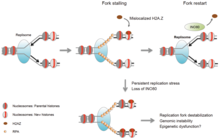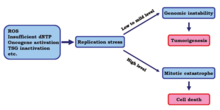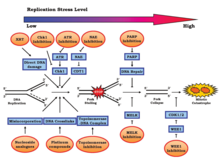
DNA replication stress refers to the state of a cell whose genome is exposed to various stresses. The events that contribute to replication stress occur during DNA replication, and can result in a stalled replication fork.
There are many events that contribute to replication stress, including:
- Misincorporation of ribonucleotides
- Unusual DNA structures
- Conflicts between replication and transcription
- Insufficiency of essential replication factors
- Common fragile sites
- Overexpression or constitutive activation of oncogenes
- Chromatin inaccessibility
ATM and ATR are proteins that help to alleviate replication stress. Specifically, they are kinases that are recruited and activated by DNA damage. The stalled replication fork can collapse if these regulatory proteins fail to stabilize it. When this occurs, reassembly of the fork is initiated in order to repair the damaged DNA end.
Replication fork

The replication fork consists of a group of proteins that influence the activity of DNA replication. In order for the replication fork to stall, the cell must possess a certain number of stalled forks and arrest length. The replication fork is specifically paused due to the stalling of helicase and polymerase activity, which are linked together. In this situation, the fork protection complex (FPC) is recruited to help maintain this linkage.
In addition to stalling and maintaining the fork structure, protein phosphorylation can also create a signal cascade for replication restart. The protein Mrc1, which is part of the FPC, transmits the checkpoint signal by interacting with kinases throughout the cascade. When there is a loss of these kinases (from replication stress), an excess of ssDNA is produced, which is necessary for the restarting of replication.
Replication block removal
DNA interstrand cross-links (ICLs) cause replication stress by blocking replication fork progression. This blockage leads to failure of DNA strand separation and a stalled replication fork. Repair of ICLs can be accomplished by sequential incisions, and homologous recombination. In vertebrate cells, replication of an ICL-containing chromatin template triggers recruitment of more than 90 DNA repair and genome maintenance factors. Analysis of the proteins recruited to stalled replication forks revealed a specific set of DNA repair factors involved in the replication stress response. Among these proteins, SLF1 and SLF2 were found to physically link the SMC5/6 DNA repair protein complex to RAD18. The SMC5/6 complex is employed in homologous recombination, and its linkage to RAD18 likely allows recruitment of SMC5/6 to ubiquitination products at sites of DNA damage.
Replication-coupled repair
Mechanisms that process damaged DNA in coordination with the replisome in order to maintain replication fork progression are considered to be examples of replication-coupled repair. In addition to the repair of DNA interstrand crosslinks, indicated above, multiple DNA repair processes operating in overlapping layers can be recruited to faulty sites depending on the nature and location of the damage. These repair processes include (1) removal of misincorporated bases; (2) removal of misincorporated ribonucleotides; (3) removal of damaged bases (e.g. oxidized or methylated bases) that block the replication polymerase; (4) removal of DNA-protein crosslinks; and (5) removal of double-strand breaks. Such repair pathways can function to protect stalled replication forks from degradation and allow restart of broken forks, but when deficient can cause replication stress.
Single-strand break repair
Singe-strand breaks are one of the most common forms of endogenous DNA damage. Replication fork collapse at leading strand nicks generates resected single-ended double-strand breaks that can be repaired by homologous recombination.
Causation
Replication stress is induced from various endogenous and exogenous stresses, which are regularly introduced to the genome. These stresses include, but are not limited to, DNA damage, excessive compacting of chromatin (preventing replisome access), over-expression of oncogenes, or difficult-to-replicate genome structures. Replication stress can lead to genome instability, cancer, and ageing. Uncoordinated replication–transcription conflicts and unscheduled R-loop accumulation are significant contributors.
Specific events
The events that lead to genome instability occur in the cell cycle prior to mitosis, specifically in the S phase. Disturbance to this phase can generate negative effects, such as inaccurate chromosomal segregation, for the upcoming mitotic phase. The two processes that are responsible for damage to the S phase are oncogenic activation and tumor suppressor inactivation. They have both been shown to speed up the transition from the G1 phase to the S phase, leading to inadequate amounts of DNA replication components. These losses can contribute to the DNA damage response (DDR). Replication stress can be an indicative characteristic for carcinogenesis, which typically lacks DNA repair systems. A physiologically short duration of the G1 phase is also typical of fast replicating progenitors during early embryonic development.
Applications in cancer


Normal replication stress occurs at low to mild levels and induces genomic instability, which can lead to tumorigenesis and cancer progression. However, high levels of replication stress have been shown to kill cancer cells.
In one study, researchers sought to determine the effects of inducing high levels of replication stress on cancer cells. The results showed that with further loss of checkpoints, replication stress is increased to a higher level. With this change, the DNA replication of cancer cells may be incomplete or incorrect when entering into the mitotic phase, which can eventually result in cell death through mitotic catastrophe.
Another study examined how replication stress affected APOBEC3B activity. APOBEC3 (apolipoprotein B mRNA editing enzyme, catalytic polypeptide-like 3) has been seen to mutate the cancer genome in various cancer types. Results from this study show that weakening oncogenic signaling or intensifying DNA replication stress can alter carcinogenic potential, and can be manipulated therapeutically.
References
- ^ Mazouzi A, Velimezi G, Loizou JI (November 2014). "DNA replication stress: causes, resolution and disease". Experimental Cell Research. 329 (1): 85–93. doi:10.1016/j.yexcr.2014.09.030. PMID 25281304.
- ^ Zeman MK, Cimprich KA (January 2014). "Causes and consequences of replication stress". Nature Cell Biology. 16 (1): 2–9. doi:10.1038/ncb2897. PMC 4354890. PMID 24366029.
- "Reactome | Activation of ATR in response to replication stress". www.reactome.org. Retrieved 2017-04-09.
- ^ Allen C, Ashley AK, Hromas R, Nickoloff JA (February 2011). "More forks on the road to replication stress recovery". Journal of Molecular Cell Biology. 3 (1): 4–12. doi:10.1093/jmcb/mjq049. PMC 3030971. PMID 21278446.
- "Replication Fork, Fork Protection Complex | Learn Science at Scitable". www.nature.com. Retrieved 2017-04-09.
- "Stalled DNA Replication Fork | Learn Science at Scitable". www.nature.com. Retrieved 2017-04-09.
- ^ Räschle M, Smeenk G, Hansen RK, Temu T, Oka Y, Hein MY, et al. (May 2015). "DNA repair. Proteomics reveals dynamic assembly of repair complexes during bypass of DNA cross-links". Science. 348 (6234): 1253671. doi:10.1126/science.1253671. PMC 5331883. PMID 25931565.
- Cortez D (June 2019). "Replication-Coupled DNA Repair". Molecular Cell. 74 (5): 866–876. doi:10.1016/j.molcel.2019.04.027. PMC 6557297. PMID 31173722.
- ^ Pavani R, Tripathi V, Vrtis KB, Zong D, Chari R, Callen E, Pankajam AV, Zhen G, Matos-Rodrigues G, Yang J, Wu S, Reginato G, Wu W, Cejka P, Walter JC, Nussenzweig A (August 2024). "Structure and repair of replication-coupled DNA breaks". Science. 385 (6710): eado3867. doi:10.1126/science.ado3867. PMC 11620331. PMID 38900911.
- ^ "Replication Stress in Mammalian Cells and Its Consequences for Mitosis (PDF Download Available)". ResearchGate. Retrieved 2017-02-11.
- King, David; Li, Xiao Dun; Almeida, Gilberto S.; Kwok, Colin; Gravells, Polly; Harrison, Daniel; Burke, Saoirse; Hallsworth, Albert; Jamin, Yann; George, Sally; Robinson, Simon P.; Lord, Christopher J.; Poon, Evon; Yeomanson, Daniel; Chesler, Louis; Bryant, Helen E. (24 September 2019). "MYCN expression induces replication stress and sensitivity to PARP inhibition in neuroblastoma". Oncotarget. 11 (23): 2141–2159. doi:10.18632/oncotarget.27329. PMC 7289530. PMID 32577161.
- Burhans WC, Weinberger M (2007). "DNA replication stress, genome instability and aging". Nucleic Acids Research. 35 (22): 7545–56. doi:10.1093/NAR/GKM1059. PMC 2190710. PMID 18055498.
- Fragkos M, Naim V (April 2017). "Rescue from replication stress during mitosis". Cell Cycle. 16 (7): 613–633. doi:10.1080/15384101.2017.1288322. PMC 5397263. PMID 28166452.
- Brambati A, Colosio A, Zardoni L, Galanti L, Liberi G (2015-04-28). "Replication and transcription on a collision course: eukaryotic regulation mechanisms and implications for DNA stability". Frontiers in Genetics. 6: 166. doi:10.3389/fgene.2015.00166. PMC 4412130. PMID 25972894.
- ^ Zhang J, Dai Q, Park D, Deng X (August 2016). "Targeting DNA Replication Stress for Cancer Therapy". Genes. 7 (8): 51. doi:10.3390/genes7080051. PMC 4999839. PMID 27548226.
- Cescon DW, Haibe-Kains B (September 2016). "DNA replication stress: a source of APOBEC3B expression in breast cancer". Genome Biology. 17 (1): 202. doi:10.1186/s13059-016-1069-y. PMC 5045630. PMID 27716362.
- Wei JY, Bulkley BH, Schaeffer AH, Greene HL, Reid PR (July 1978). "Mitral-valve prolapse syndrome and recurrent ventricular tachyarrhythmias: a malignant variant refractory to conventional drug therapy". Annals of Internal Medicine. 89 (1): 6–9. doi:10.1523/JNEUROSCI.15-09-06046.1995. PMC 6577667. PMID 666188.
- Taylor EM, Lindsay HD (January 2016). "DNA replication stress and cancer: cause or cure?" (PDF). Future Oncology. 12 (2): 221–37. doi:10.2217/fon.15.292. PMID 26616915. S2CID 20261656.
- Kanu N, Cerone MA, Goh G, Zalmas LP, Bartkova J, Dietzen M, et al. (September 2016). "DNA replication stress mediates APOBEC3 family mutagenesis in breast cancer". Genome Biology. 17 (1): 185. doi:10.1186/s13059-016-1042-9. PMC 5025597. PMID 27634334.